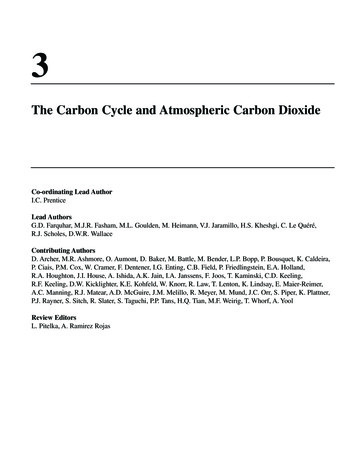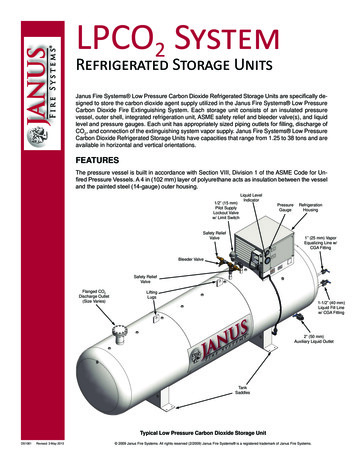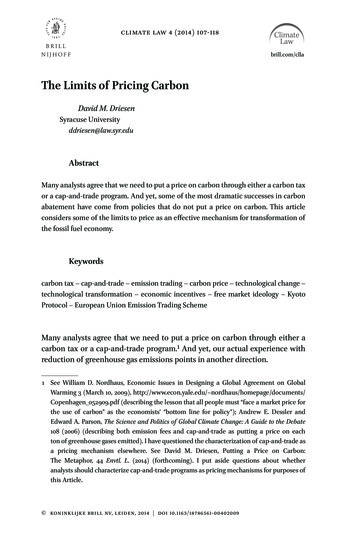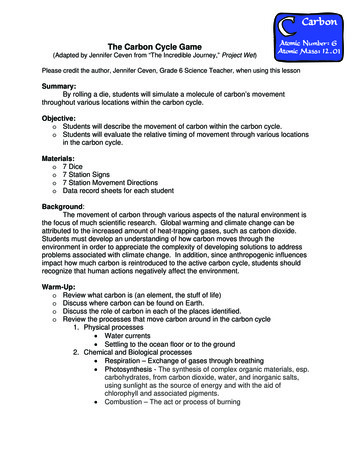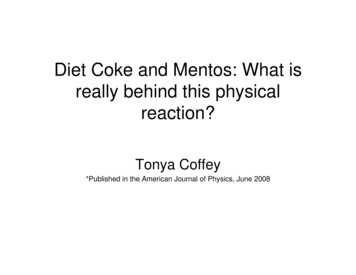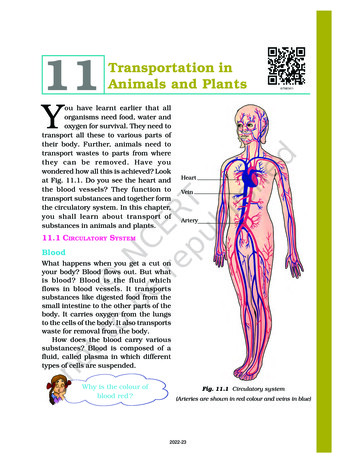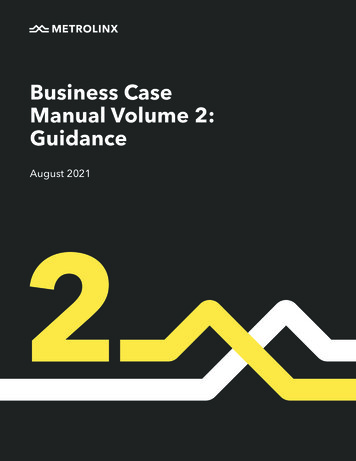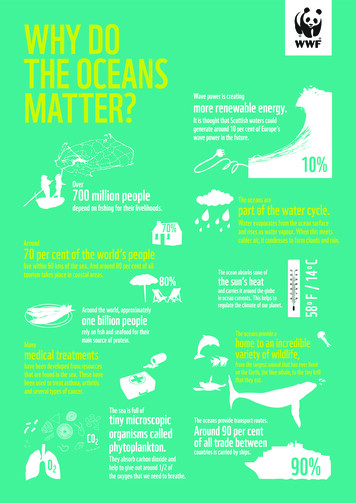
Transcription
They absorb carbon dioxide andhelp to give out around 1/2 ofthe oxygen that we need to breathe.
ACTIVITY 1FACT SHEET:WHY DO THE OCEANS MATTER?1Over 700 million people depend on fishingfor their livelihoods.2Around 70 per cent of the world’s peoplelive within 60 kms of the sea. And around80 per cent of all tourism takes placein coastal areas.3Around the world, approximately one billion people rely on fish andseafood for their main source of protein.4Many medical treatments have been developed from resources thatare found in the sea. These have been used to treat asthma, arthritisand several types of cancer.5The sea is full of tiny microscopic organisms called phytoplankton.They absorb carbon dioxide and help to give out around half of theoxygen that we need to breathe.6Wave power is creating more renewable energy. It is thought thatScottish waters could generate around 10 per cent of Europe’s wavepower in the future.7The oceans are part of the water cycle. Water evaporates from theocean surface and rises as water vapour. When this meets colder air,it condenses to form clouds and rain.8The ocean absorbs some of the sun’s heat and carries it around theglobe in ocean currents. This helps to regulate the climate of our planet.9The oceans provide a home to an incredible variety of wildlife, fromthe largest animal that has ever lived on the Earth, the blue whale,to the tiny krill that they eat.10The oceans provide transport routes. Around 90 per cent of all tradebetween countries is carried by ships.
Photo: Martin Harvey / WWF.
Photo: Shutterstock / Rich Carey / WWF.
Photo: WWF/Troy Mayne.
Photo: WWF / Greg Armfield.
ACTIVITY 5PLASTIC POLLUTION IN GREENSEA COVEROLE PLAY CARDSManager of the Greensea Cove tourist officeTourism brings much-needed money into yourquiet seaside town. But the beaches are full oflitter and most of it comes from food packagingand plastic bags that people leave behind. You areworried that unsightly rubbish on the beach willkeep tourists away. Hotels, shops and other localbusinesses will lose customers.You believe the council should do more toclean up the beaches and provide betterrubbish disposal and recycling services.Photo: PhotospinEnvironmentalistYou are worried because the plastic left on the beachesis polluting the seas and affecting wildlife. For you, theproblem is not how to dispose of plastic waste, but howto make sure that there is less of it in the first place.You believe that more than half the plastic rubbishthat homes throw away comes from supermarketpackaging.You think that supermarkets should pay a taxon all plastic packaging, just as they do onplastic bags.Photo: WWF Intl. / Jonathan Diamond / The StandWWF Oceans and Plastics KS2 Activity5 Role playing cards.indd 123/08/2018 00:04
Resident of Greensea CoveYou moved to Greensea Cove to live near itsbeautiful beaches. But you have noticed that it’sbecoming more littered with plastic. You helpto organise a beach clean-up every year, but therubbish keeps piling up. Visitors enjoy picnics onthe beach, but they often leave their litter behind.The rubbish bins are always full, and litter blowsinto the sea.You know that this pollutes the seas andcan kill wildlife.Photo: PhotospinSupermarket managerYou are the manager of the supermarket inGreensea Cove. You know that your customersexpect the best food at low prices. Plastic packagingkeeps your food fresh and clean. It’s also strong,which means that less food is damaged when it istransported. This means that less food is wasted.You want to keep your customers happy andkeep prices down – after all, you don’t wantthem to shop at a different supermarket!Photo: PhotospinLocal councillorPlastic rubbish is a big problem in Greensea Cove.You want visitors to keep coming to the beach (theybring in money), but it costs the council a lot to providerubbish bins and recycling services. The council does nothave a lot of money to spare and you have many servicesto pay for including local transport, care for the elderly,education services, libraries and parks. Who should payfor rubbish disposal?Photo: PhotospinWWF Oceans and Plastics KS2 Activity5 Role playing cards.indd 2You are going to be chairing this meetingand inviting people to present their views.Make sure that everyone has the chance to beheard and ask them what can be done to solvethe problem.23/08/2018 00:04
ACTIVITY 3OCEANS AND PLASTICS QUIZANSWERSRIGHT!1Oceans cover about 70 per cent of our planet’s surface.2In the UK, we eat 2.5 billion worth of seafood each year.WRONG!TRUE: Oceans cover 71 per cent of our planet’s surface and make up95 per cent of all the space available to life.FALSE: In the UK, we actually eat a staggering 4.5 billion worth ofseafood each year, with the most common fish eaten in the UK beingsalmon, tuna and cod.3Only 30 per cent of the ocean is protected.4Around half of the oxygen that we breathe comes from the ocean.5It can take fishing lines 300 years to degrade in the ocean.FALSE: Only 4 per cent of the ocean is under some form of protection.We need to do far more to protect our oceans and the plant and animalspecies that live there, as well as provide a healthier future for us too!TRUE: Tiny marine organisms, called phytoplankton producearound 50 per cent of the oxygen that we breathe.FALSE: According to some sources, sadly, it can take twice as long asthis – 600 years. Around 10 per cent of all rubbish in the sea comes fromthe fishing industry. Nets and fishing gear can get lost or thrown awayand these ‘ghost nets’ can keep trapping fish, seals, turtles and other sealife for years.
6By 2050, oceans could contain more plastic than fish.7About 45 per cent of plastic waste is properly recycled.8On average there are 358 items of litter per square kilometre on Britain’ssea floor.TRUE: We are producing around 20 times more plastic than we did50 years ago and this is expected to double again in the next 20 years.Much of this ends up in the sea.FALSE: In fact, just 9 per cent of all plastics are recycled. Around40 per cent of our plastic ends up in landfill and a third finds its wayinto fragile ecosystems such as the world’s oceans.TRUE: The amount of litter on Britain’s sea floor has increased by over200% since 1992 and nearly 80% of this is plastic.9Over 80 per cent of pollution in the sea comes from activities that havetaken place on land.TRUE: Most of our waste eventually reaches the sea. If they are notthrown away carefully, plastics can enter drains and rivers. Fertilisersand pesticides from farms and gardens can run to the sea and in manyparts of the world, untreated sewage is pumped into the ocean.10Microplastics are found in over 75% of mussels taken from Britishbeaches.TRUE: According to research, microplastics are found in up to 80%of mussels taken from British beaches! Every day millions ofmicroplastics enter the sea from products such as toothpaste andscrubs, so we need to reduce the amount of plastic entering the oceans.
ACTIVITY 3OCEANS AND PLASTICS QUIZQUESTIONSDiscuss these statements with a partnerand agree on whether you think that theyare true or false. Circle your answer on the sheet.TRUE?FALSE?1Oceans cover about 70 per cent of ourplanet’s surface.TRUE / FALSE2In the UK, we eat 2.5 billion worth ofseafood each year.TRUE / FALSE3Only 30 per cent of the ocean is protected.TRUE / FALSE4Around half of the oxygen that we breathecomes from the ocean.TRUE / FALSE5It can take fishing lines 300 years to degradein the ocean.TRUE / FALSE6By 2050 oceans could contain more plasticthan fish.TRUE / FALSE7About 45 per cent of plastic waste is properlyrecycled.TRUE / FALSE8On average there are 358 items of litter persquare kilometre on Britain’s sea floor.TRUE / FALSE9Over 80 per cent of pollution in the seacomes from activities that have taken placeon land.TRUE / FALSE10Microplastics are found in over 75% ofmussels taken from British beaches.TRUE / FALSE
ACTIVITY 4THE LAST STRAW?SCENARIO AND SET OF STATEMENTSDan uses a plastic straw to drink his juice when he goes for a picnic in the localpark. How might this end up on his dinner plate?.1Zooplankton, are eaten by a huge variety of animals including small fish,penguins, and the largest animal on Earth, the blue whale.2Dan is having a picnic. He sips his juice through a bright orangeplastic straw.3According to the BBC, it is estimated that in the UK we throw away42 billion plastic straws a year. That’s around 640 per person.4After being eaten by minute organisms such as zooplankton, microplasticscan pass up the food chain, from smaller fish to bigger fish, and eventuallyto us.5Some human-made materials, like plastic, that end up in the ocean couldtake hundreds of years to degrade.6Unfortunately, Dan does not pick up all the litter from his picnic.The straw blows into the gutter by the road.
.7Plastics look like food to many animal species. Marine turtles canmistake plastic bags for jelly fish, their favourite food.8Zooplankton, tiny animals that live in the sea, can eat microplastics.9Dan’s favourite food is fish and chips.10In the sea, plastics break up into tiny pieces called microplastics.These are less than 5mm in size.11When it rains, litter is carried away down the drain. It ends up inthe river which flows into the sea.12Fish are caught and sold to people who eat them for dinner.
.Accordingtostrawthe BBC,it is estimatedthatheingoesthe UKthrowawayDan usesa plasticto drinkhis juice whenfor awepicnicin 640perperson.park. How might this end up on his dinner plate?3.821ACTIVITY4.Zooplankton, tiny animals that live in the sea, can eat microplastics.4THELAST STRAW?1.After being eaten by minute organisms such as zooplankton, microplasticsACTIVITY4.can 4pass up the food chain, from smaller fish to bigger fish, and eventuallyACTIVITYZooplankton,are eaten by a huge variety of animals including small fish,.to us.penguins,andthelargestanimalon Earth,theMarineblue whale.Plasticslooklikefoodto manyanimalspecies.turtles od.Dan’s favourite food is fish and chips.Plastics look like food to many animal species. Marine turtles can.mistakeplastic bagsmaterials,for jelly that endup in the ocean could.Danishavingapicnic.Hesipshisjuicethrougha bright orangetake hundreds of years to degrade.plasticstraw.Dan usesa plasticstraw to drink his juice when he goes for a picnic in the localDan uses a plastic straw to drink his juice when he goes for a picnic in the localZooplankton,live plate?in the sea, can eat microplastics.park. Howmight thistinyendanimalsup on histhatdinner.park. How might this end up on his dinner plate?.In the sea, plastics break up into tiny pieces called microplastics.Theseare less tinythananimals5mm in size.live in the sea, can eat microplastics.Zooplankton,Unfortunately,Dan does notthatpick up all the litter from his picnic.AccordingtotheBBC,it gutteris estimatedin the UK we throw away.The straw blows into theby thethatroad.42 billion plastic straws a year. That’s around 640 per person.Zooplankton, are eaten by a huge variety of animals including small fish,.Dan’sfavouritearefoodis fishchips.Zooplankton,eatenby anda hugevariety of animals including small fish,penguins, and the largest animal on Earth, the blue whale.penguins,andthelargestanimalonEarth,blue Itwhale.When it rains, litter is carried away downthethedrain.ends up NARIOANDSETSETOFOFSTATEMENTSSTATEMENTS7SCENARIO AND5281068391111 theriverwhichflowsintosea.Afterbeingeatenby ps. such as zooplankton, microplastics.94.can pass up the food chain, from smaller fish to bigger fish, and eventually7227to neturtlesDanis havingalikepicnic.Hehisanimaljuicethrougha brightorange.Danis havinga picnic.He sipshisjuicethrougha vouritefood.mistakeplastic bags for jelly fish, their favourite food.plasticstraw.Inthe sea,plastics break up into tiny pieces called microplastics.plasticstraw.Thesearelessin peoplesize. who eat them for dinner.Fish are caughtthanand5mmsold to.Somematerials,likeplastic,endmicroplastics.up in the ocean couldInthe human-madesea, plastics breakup intotinypiecesthatcalled.take hundredsof yearstoindegrade.Theseare less than5mmsize.According to the BBC, it is estimated that in the UK we throw away.According to the BBC, it is estimated that in the UK we throw away42billion plasticstrawsa at.42billion plasticstrawsa year.That’saround640perperson.Whenit rains,is carriedawaydown thedrain.MarineIt ends turtlesup in canPlasticslook litterlike foodto manyanimalspecies.theriver h,theirfavouritefood.Unfortunately, Dan does not pick up all the litter from his picnic.101251033881176.The strawblowsintoisthegutterawayby theroad.Whenit rains,littercarrieddownthe drain. It ends up in.11Afterbeingeatenby minuteorganismssuch as zooplankton, microplastics.theriverwhichflowsintothesea.After being eaten by minute organisms such as zooplankton, microplastics4.pass up the food chain, from smaller fish to bigger fish, and eventually4 cancan pass up the food chain, from smaller fish to bigger fish, and eventuallyto us.toDan’sus. chips.Dan’sFish are caught and sold to people who eat them for dinner.Zooplankton, tiny animals that live in the sea, can eat microplastics.912985125.Fish are caught and sold to people who eat them for dinner.Some human-made materials, like plastic, that end up in the ocean couldSome human-made materials, like plastic, that end up in the ocean could.take hundreds of years to degrade.Dan is having a picnic. He sips his juice through a bright orangeplasticstraw. are eaten by a huge variety of animals including small fish,Zooplankton,penguins, and the largest animal on Earth, the blue whale.3 a perperson.Statementsis havinga thatpicnic.sips alongsidehisjuicethroughbrightorange2 Danplastic straw.thecompleted timelineAccording to the BBC, it is estimated that in the UK we throw away.being eaten by minute organisms such as zooplankton, microplastics4 Aftercanpassuptothechain,from smallerto biggerandawayeventuallythefoodBBC,it is estimatedthatfishin theUK wefish,throwACTIVITY43 toAccording42us.billion plastic straws a year. That’s around 640 per person.THE LAST STRAW?ANDSETminuteOF STATEMENTSSomehuman-madelike plastic,thatup in the oceancouldAfter beingeaten bymaterials,organismssuchas syearsto degrade.can passup theoffoodchain,from smaller fish to bigger fish, and eventually.to us.Dan uses a plastic straw to drink his juice when he goes for a picnic in the localpark. How might this end up on his dinner ineturtlesturtlescancanUnfortunately, Dan does not pick up all the litter from his tefood.The straw blows into the gutter by the road.Some human-made materials, like plastic, that end up in the ocean could.take hundreds of years to degrade.Zooplankton, are eaten by a huge variety of animals including small fish,1.penguins, and the largest animal on Earth, the blue astics.microplastics.Unfortunately,Dandoesnot pickallinlitterhispicnic.8.86 Zooplankton,The straw blows into the gutter by the road.Dan is having a picnic. He sips his juice through a bright orange299plastic straw.Dan’s favourite food is fish and chips.3Dan’s favourite food is fish and chips.According to the BBC, it is estimated that in the UK we throw away42 billion plastic straws a year. That’s around 640 per person.take hundreds of years to cs.microplastics.InInthe.1041066.10109These s arefavouritefood is fishand chips.Unfortunately, Dan does not pick up all the litter from his picnic.Unfortunately, Dan does not pick up all the litter from his picnic.The straw blows into the gutter by the road.The straw blows into the gutter by the astics.microplastics.Aftereatenby minuteorganismssuch as zooplankton, lessthan5mmininsize.can pass up the food chain, from smaller fish to bigger fish, and eventuallyto us.When it rains, litter is carried away down the drain. It ends up in
ACTIVITY 6MY PLASTIC DIARYYour name .
1 Over 700 million people depend on fishing for their livelihoods. . 5 The sea is full of tiny microscopic organisms called phytoplankton. . 10 In the sea, plastics break up into tiny pieces c
